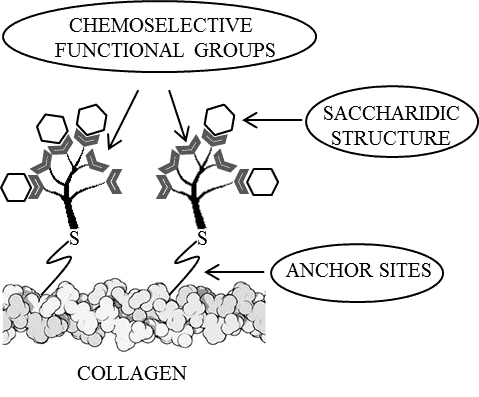Collagen is the most abundant protein in the body and a major component of the extracellular matrix (ECM); it has been widely used both in vitro and in vivo and has been shown to have suitable properties for TE applications1, 2. One emerging feature is collagen glycosylation, reported as relevant in determining physiological and pathological states3. Multivalent recognition between carbohydrate ligands and their binding receptors mediates crucial biological processes4. With this in mind, we have approached the immobilization of dendron structures to collagen patches through the thiol–ene click chemistry, for further chemoselective bioconjugation reactions to selected saccharidic structures.

References
1Materials biofunctionalization for tissue regeneration. L. Cipolla, L. Russo, N. Shaikh, F. NicotraPOLYMERIC BIOMATERIALS III ED, Vol. I Polymers as Biomaterials CRC Press, 2013 Polymeric Biomaterials: 2 Volume Set, Third Edition Published: January 15, 2013 by CRC Press -1-710 Pages ISBN 9781420094725.
2Smart biomaterials: the contribution of glycoscience. L. Cipolla, L. Russo, F. Taraballi, C. Lupo, D. Bini, L. Gabrielli, A. Capitoli and F. Nicotra. Specialist Periodical Reports, SPR Carbohydrate Chemistry, 2012, Vol. 38, , in press ISBN: 9781849734394
3A Novel Functional Role of Collagen Glycosylation. H. J. Jürgensen, D. H. Madsen, S. Ingvarsen, M. C. Melander, H. Gårdsvoll, L. Patthy, L. H. Engelholm, and N. Behrendt. Journal of biological chemistry 2011
4For reviews on lectins, see: a) H. Lis, N. Sharon, Chem. Rev. 1998, 98, 637 –674; b) H.-J. Gabius, Adv. Drug Delivery Rev. 2004, 56, 421 – 424; c) H.-J. Gabius, S. André, H. Kaltner, H.-C. Siebert, Biochim. Biophys. Acta Gen. Subj. 2002, 1572, 165 –177; d) M. Ambrosi, N. R. Cameron, B. G. Davis, Org. Biomol. Chem. 2005, 3, 1593 –1608.

